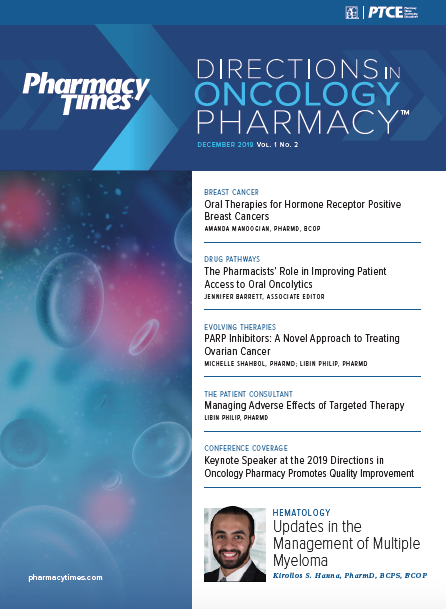Publication
Article
Pharmacy Practice in Focus: Oncology
Current and Future Considerations for Oncology Biosimilars in 2020
Author(s):
The US health care system expects 2020 to be a year of major cost savings, in part because of the projected significant traction from 3 major biosimilars for rituximab (Rituxan), bevacizumab (Avastin), and trastuzumab (Herceptin), which accounted for a total of $19.4 billion in sales in 2018.
The US health care system expects 2020 to be a year of major cost savings, in part because of the projected significant traction from 3 major biosimilars for rituximab (Rituxan), bevacizumab (Avastin), and trastuzumab (Herceptin), which accounted for a total of $19.4 billion in sales in 2018.1 Genentech’s October 2014 shift of its distribution model for rituximab, bevacizumab, and trastuzumab from an open-channel to a limited-distribution model has since cost US hospitals approximately $300 million, according to estimates.2 Based on historical discounts for biosimilars (20%-30%) and changes in their distribution model favoring US hospitals, the health care system has the potential to realize cost savings of up to $5 billion in 2020 with oncology biosimilars.
According to a recent report by the Institute of Clinical and Economic Review, between 2017 and 2018, the prices for 7 individual drugs grew significantly, a collective hike that was responsible for an overall increase of $5.1 billion in drug expenses for the health care system.3
The report highlights the lack of any new clinical evidence to support these increases of more than twice the rate of medical inflation. Of the 7 drugs, adalimumab (Humira) and rituximab accounted for 51% of the increased costs, at $1.8 billion and $800 million, respectively.3
In fact, the manufacturer of rituximab stated that its decision to increase the price of the drug was justified by the right balance between patient access and the company’s ability to further invest in possible breakthrough therapies.2 This truly speaks to the fragmentation of the US health care system and the need for a significant overhaul to achieve a balance among innovation, cost, and sustainability of the system. One strategy for accomplishing this is for every health system and payor to aggressively pursue the conversion to biosimilars.
The 7 drugs, in order of the impact of their price increases on drug spending in the United States, are3:
- Adalimumab (AbbVie)
- Rituximab (Genentech)
- Pregabalin (Lyrica; Pfizer)
- Tenofovir disoproxil fumarate (Truvada; Gilead)
- Pegfilgrastim (Neulasta; Amgen)
- Tadalafil (Cialis; Eli Lilly)
- Dimethyl fumarate (Tecfidera; Biogen)
Results released by the Center for Medical Economics and Innovation at the Pacific Research Institute showed that if the focus of the United States health care system were placed solely on biosimilar products currently on the market and an achievement of a 75% biosimilar conversion rate, the US health care system would save $7 billion.4 This would still be less than the current market share held by biosimilar products in many European nations.4
This makes the slow adoption of these products even more surprising, yet several reasons are behind this slow adoption, including a significant rebate system that gives payers incentives to prefer a reference product. Why would a provider switch their patient to a biosimilar when the patient’s insurance is covering the reference product? This preferential coverage of the reference biologic may provide payers financial relief on a drug initially. But as other new biosimilars enter a market in which manufacturers are not offering rebates and the health system is slow to adopt these products, the result will be higher costs to payers. This could lead to the reversal of most, if not all, their savings from that onetime rebate.4
Unfortunately, because many providers have no experience with biosimilar adoption, the market share needed to optimize the savings could take years to reach. Another barrier to conversion is that, because the patient/provider sees no immediate financial impact, convincing patients of the long-term benefits, to both them and the community at large, is more difficult. A potential solution is to consider this from the payer perspective. Although the benefits may not be apparent immediately, choosing a biosimilar will help to lower or stabilize premiums or deductibles in the future because payers would spend less, and this savings could be passed on to their members.4
In addition to the cost savings, multiple clinical and operational considerations may also impede the adoption of biosimilars, including the understanding of what biosimilarity is, the extrapolation of indications, skinny label and interchangeability designation, and the off-label use of biosimilars. Regarding biosimilarity and the extrapolation of indications, despite the FDA’s well-established pathways and scientific justification, many providers struggle with the requirement that manufacturers study 1 indication, or in healthy volunteers, and then extrapolate the biosimilar to multiple other indications.
There is great value in providing more education about this setting. When providers understand the scientific rationale and justification, they are able to convey appropriate clinical messages to their patients and may, in the future, help develop a more streamlined process for biosimilar adoption within health systems. The approval of skinny label, in which follow-on manufacturers seek approval for only some of the approved indications of a branded drug, also contributes to the concern that a product is not a true biosimilar or has a different mechanism of action for an indication because it is not specifically approved for all indications.
However, this practice is merely a strategy for the developer to avoid patent litigation around specific indications. Often, very low uptake of a biosimilar is caused by confusion about the biosimilar product’s interchangeability and a lack of consensus about when to switch agents for an existing patient.
This leads to a situation in which only new patients are initiated on the product, thereby slowing the adoption of biosimilars in general. Although state regulations around interchangeability do not apply to the scope of biosimilar use within health systems and are meant more for the retail pharmacy setting, confusion may exist regarding the application of these regulations within health systems. Lastly, although clinicians can use several reference biologics, such as rituximab and infliximab (Remicade), for many off-label indications, because these indications were not vetted by the FDA through its scientific justification process for biosimilarity, providers may harbor concerns about their use for indications outside the label’s recommendations.
Despite these roadblocks, a strong trend toward biosimilar development and adoption is already evident in the United States. Janet Woodcock, MD, cochair of the Biosimilar Implementation Committee, recently shared at the DIA Biosimilars Conference that 83 biosimilars are in development and registered with the FDA for 38 different biologics.5
At Boston Medical Center, our conversion rate for biosimilars has been an outstanding 98%. We believe this is the highest in the country and are forecasting 2020 to be the year our system realizes the highest cost savings—thanks to a strong commitment to, and continued adoption of, biosimilars. It is truly exciting to see multiple manufacturers successfully launching biosimilars for complex biologics that treat malignancies and help curb health care costs.
Currently, the 3 major biosimilars in oncology (rituximab, bevacizumab, and trastuzumab) each place among the top 5 biologic drugs driving the highest spend. To continue increasing biosimilar adoption, health systems should begin collaborating on their implementation strategies, publishing real-world evidence, and establishing best practices, which is what could be the key to increasing biosimilar adoption across the United States.
Bhavesh Shah, RPh, BCOP, is director of specialty and hematology/oncology pharmacy at Boston Medical Center (BMC) in Massachusetts, the primary teaching affiliate for Boston University School of Medicine and the largest safety net hospital in New England.
Noreen Palinkas is the director of pharmacy compliance for BMC.
REFERENCES
- Was the $47 Billion Acquisition of Genentech in 2009 A Good Deal for Roche? https://www.forbes.com/sites/greatspeculations/2019/07/10/was-the-47-billion-acquisition-of-genentech-in-2009-a-good-deal-for-roche/#55afc8d8a1aa. Updated July, 20 2019. Accessed November 3, 2019.
- Survey Results: Genentech’s Decision to Change Distribution of Critical Cancer Drugs Raises Costs, Reduces Availability. https://www.businesswire.com/news/home/20150302006273/en/Survey-Results-Genentech%E2%80%99s-Decision-Change-Distribution-Critical Updated March 2, 2015. Accessed November 3, 2019.
- Unsupported Price Increase Assessment: Final Assessment Report. https://icer-review.org/wp-content/uploads/2019/01/ICER_UPI_Final_Report_and_Assessment_100819_Final.pdf. Updated October 8, 2019. Accessed November 3, 2019.
- Humira, Rituxan top list of U.S. drugs with biggest price increases: report. https://www.reuters.com/article/us-usa-healthcare-drugpricing/humira-rituxan-top-list-of-u-s-drugs-with-biggest-price-increases-report-idUSKBN1WN1BE. Accessed November 3, 2019
- New Biosimilar Study Shows Massive State and Tax Payor Savings Possible by Expanding Biosimilar Market. https://www.pacificresearch.org/new-issue-brief-new-biosimilars-study-shows-massive-state-and-taxpayer-savings-possible-by-expanding-biosimilars-market/ Updated October 2, 2019. Accessed November 3, 2019
- FDA's Woodcock: Biosimilar Development Promotes Future Of Better Biologics. https://www.biosimilardevelopment.com/doc/fda-s-woodcock-biosimilar-development-promotes-future-of-better-biologics-0001. Updated September 30, 2019. Accessed November 3, 2019

Newsletter
Stay informed on drug updates, treatment guidelines, and pharmacy practice trends—subscribe to Pharmacy Times for weekly clinical insights.






